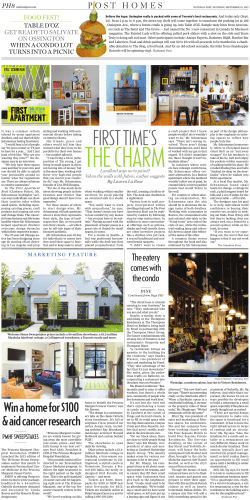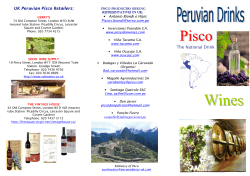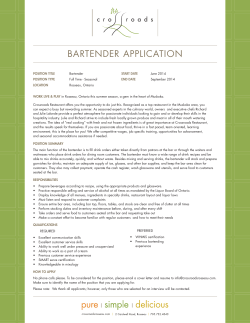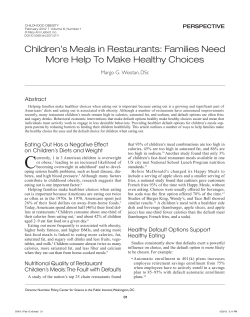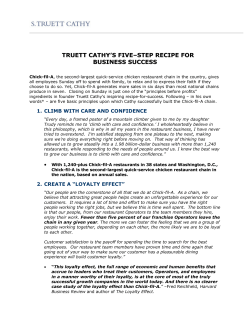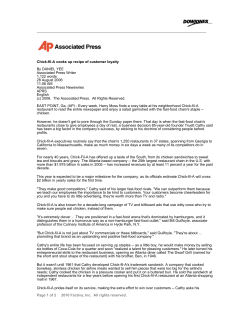
Document 86713
There are a few things you can count on daily in Lima, Peru: It will not rain; there will be an exquisite sunset over the Pacific Ocean; and a brand new ingredient will quietly fall into the repertoire of a Peruvian chef. If the chef happens to be Gaston Acurio, you can also count on a story to accompany the new ingredient, and it usually starts like this: “Well, there’s a guy….” Typically, the guy has brought Gaston a new bean, lettuce or a never-before-seen potato that will quickly find its way onto menus and become yet another piece to the overlooked, undervalued puzzle of Peruvian cuisine. “Every day, I discover and use a new ingredient,” Gaston tells me. “It’s a gift.” I ’m reclining on a couch, and as a breeze slips in the wide-open window, I catch a whiff of stew cooking in the next room. We’re in a century-old mansion, aptly called a taller, the Spanish word that denotes the workshop of an artist or craftsman. This is where Gaston, 40, plays with new ingredients, creates new dishes and works toward his mission of taking Peruvian food global. I’m near the end of a visit to Lima, and Peruvian food is a lot less mysterious to me than it was a week ago. Before I arrived, my acquaintance with food from this country Peru’s Progressive B y M e l a n i e D . g . Palate K a p l a n Lima moves beyond ceviche with a refreshing menu of new restaurants and culinary approaches. was limited to a savory Peruvian chicken joint in Virginia. But I quickly learned that the cuisine here is so much more than pollo. It’s fish that melts in your mouth, desserts that seduce you night after night, and fruit that is too exotic and wonderful to find in the United States. Since Peruvian cuisine is fairly new on the fashionable food front and many young, beautiful Peruvian chefs are now armed with European culinary training, it’s an exciting time to be eating in Lima. In the last couple days alone, I’ve met three chefs younger than 30 who plan to open up their own restaurants this year. “We are pioneers,” Gaston says. “We are inventing, and our product is Peruvian food.” As any chef will tell you, good Peruvian food has been around for centuries (after he reminds you that the potato and tomato originated here). But for most of that time, Peruvians didn’t believe their food fit the standards of fine dining. If you wanted to take someone to a nice dinner here 10 to 15 years ago, locals told me it would be Italian or French, and if they ordered a cocktail, it was more likely to be whiskey than pisco, the locally produced liquor. This, coupled with the fact that the upper class generally looked down on jobs not in the medical or legal fields, didn’t bode well for the future of Peruvian gastronomy. Fortunately, these pioneering chefs ditched their business degrees (and sometimes defied their parents) to mix new cooking skills with ancestors’ recipes, use colorful, fresh ingredients, and present them beautifully in spectacularly designed restaurants. And it’s set off nothing less than a revolution. The 2008 Guia Gastronomica del Peru, a local Zagat’s guide of sorts, claims in its introduction, “The dream of positioning our cuisine in its rightful place, demonstrating all its wealth to the world, has now become Getting There Direct flights to Lima, Peru, are available on Avianca, Copa and Grupo TACA airlines from Washington Dulles International Airport. page 16-17: Michele molinari/alamy Getting Around lunch one day, with Renato Peralta, a wellknown restaurant consultant, and Kike Matsufuyi, who is opening an outpost of La Mar in San Francisco’s Embarcadero in July. We sit for more than two hours in the thatched roof restaurant, ordering dish after dish under the loud Latin music. Renato tells me meals that last the better part of the afternoon are typical. “In Peru,” he says, “everything revolves around food.” Two other places to eat fabulous fish are Costanera 700 (Av. Del Ejército 421, Miraflores, 421-4635), which is Nikkei, or Japanese-Peruvian, and Hanzo (Prolongacion Primavera 1494, Surco, 344-4801). Both use Peruvian flavors and offer plenty of seafood with traditional Japanese dishes. Fiesta (Av. Reducto 1278, Miraflores, 242-9009, www. restaurantfiesta gourmet.com) is one of the best places to find Chiclayo, or northern Peruvian cuisine, featuring dishes with duck, baby goat ribs and beef. And Tanta (Av. Pancho Fierro 115, San Isidro, 421-9708; three other locations), another one of Gaston’s restaurants, serves breakfast, lunch, dinner, coffee, liquor and desserts. La Gran Fruta (Las Begonias 463, San Isidro, 422-0606, www.lagranfruta.com; two other locations) serves sandwiches and fresh juices from fruits like the granadilla and lucuma. One of the first restaurants to show the world that Peruvian food can—and should—be served in a white-tablecloth restaurant is Gaston’s Astrid y Gaston (Calle Cantuarias 175, Miraflores, 444-1496, www.astridygaston.com), which he opened with his wife nearly 15 years ago. I took breaks from my culinary adventure for a surfing lesson in Coste Verde and a stroll through Larcomar (Malecón de la Reserva 610, Miraflores, 620-6000, www.larcomar.com), an oceanside entertainment center with restaurants, shops, a theater and bowling alley. I also made an expensive trip to Dédalo (Paseo Sáenz Peña 295, Barranco, 477-0562), a bright and whimsical store a block from the ocean in Lima’s Barranco district (known as the bohemian neighborhood). The store has room after room of handmade bowls, jewelry, clothes, games and toys, with plenty of quirky recycled materials and a little café in the back garden, which serves tea, treats and sushi. Renato took me to several city markets with fish, meat, flowers, spices and washingtonflyer.com Gaston Acurio portrait and food: courtesy of gaston acurio a reality.” Today, the culinary profession is not only accepted in Peru, but chefs have become ambassadors, cheered on by Peruvians for bringing them good food. Chefs work in a playground of ingredients where the sky is the limit. The best restaurants in the capital city are now Peruvian, and the most popular drinks are made with pisco. (Pisco sour, made with pisco, sugar, lime juice and egg white, is known as the national drink. Drink more than two, locals say, and you won’t remember anything tomorrow.) “There has been a boom in cooking schools and restaurants in the last decade,” says Lisette Sarfaty, who opened her Mediterranean-Peruvian restaurant, Tabla (Elias Aguirre 698, Miraflores, 243-3088, www.restaurante tabla.com.pe), two years ago. She says the inherently good food can be attributed largely to the country’s microclimates, which include coast, highlands and jungle. Every plant and animal used in the traditional dishes is native to Peru, and chefs say that they don’t need to import a thing. “Peruvians have sazon, or seasoning,” Lisette says. “We also have the flavors from our immigrants— Chinese, Africans, Italians, Japanese—so we have a lot of fusion. No matter what type of food you eat in Peru, it’s good food.” Thanks to the Humboldt Current, which brings very cold water up from the Antarctic and makes it especially nutrient-rich, the water along the Peruvian coast is one of the world’s best sources of fish. “I’ve been to the Atlantic, the Caribbean, the northern Pacific, and the fish is not the same,” says Javier Morante, the executive chef at El Olivar Restaurant (Pancho Fierro 194 San Isidro, 712-6000, www.sonesta.com/Lima). “It’s a different taste here. It’s better.” That fresher fish also makes the ceviche extraordinary. Considered the national dish, ceviche is made from small pieces of raw fish (often sole, but it can also be octopus, tuna or clams), marinated in lime juice and tossed with thin slices of chili peppers and onions, which creates a wonderfully tangy, spicy dish. It’s served with roasted corn kernels, sweet potatoes and banana chips. Cevicherias, open only for lunch, originated as small, casual beachside cafés that served the morning’s catch, but Gaston has helped make the cevicheria more upscale with his restaurant La Mar (Av. La Mar 770, Miraflores, 421-3365). I join him there for Lima native Gaston Acurio and his company have four restaurant concepts with dozens of locations around Latin America. This year, he will expand to the United States and also hopes to roll out five new restaurant brands. On a warm morning in Lima, Gaston spoke with Melanie D.G. Kaplan about hot pepper power, dim sum dinners, his escape from law school and celebrity status. melanie d.g. kaplan The Miraflores Park Hotel (Malecon de la Reserva 1035, Miraflores, 610-4000, www.mira-park.com; standard doubles start at $435 year-round, including full breakfast buffet) is a boutique property in a residential section of Miraflores. Go for the beautiful location, ocean views, rooftop pool and Poissonerie Restaurant; stay for the fabulous showers, the in-room saunas and the full-service Zest Spa, which has an invigorating Peruvian olive oil and brown sugar body polish treatment. The JW Marriott Hotel Lima (Malecon de la Reserva 615, Miraflores, 217-7000, www. marriott.com; standard rooms start at $300 May to November) is one of the best-situated hotels for tourists, located across from Larcomar and close to restaurants and the Inca Market. The hotel has panoramic views of the Pacific, a full gym, tennis courts and a casino. The Swissotel Lima (Via Central 150, Centro Empresarial Real, San Isidro, 611-4400, www. swissotel.com/lima; standard rooms start at $440) is a favorite of business travelers. Two blocks from the Lima Golf Course, the hotel is starting a major expansion this year, which will include the addition of 80 suites, a grand ballroom and a fullservice spa. Sonesta El Olivar Lima (Pancho Fierro 194, San Isidro, 800-SONESTA or 712-6000, www.sonesta. com/lima; standard doubles are $290 year-round) is located in a leafy and peaceful section of the San Isidro district. There is a rooftop pool, full gym with fitness classes next door and two restaurants, Ichi Ban and El Olivar Restaurant, which has a Peruvian sancochado buffet. The Jorge Chavez Airport is 30 to 45 minutes from Miraflores and San Isidro, depending on traffic. Hotel cars are the most expensive. Some properties charge more than $40 for an airport transfer, but when pressed, the concierge should find you a reputable taxi service for a $12 lift to the airport. Local currency is the nueva sol (the rate is 2.85 soles to every $1), but most restaurants and merchants readily accept U.S. dollars. Dishing with Lima’s La Plaza Mayor Where to Stay produce, including Mercado Central (where you can see bovine stomachs hanging like big white blankets and tongues as big as baseball bats), Mercado de Surquillo and Gran Mercado Inca in San Isidro, the most upscale of the three. One morning, I tour downtown Lima with Isabelle Isenschmid, a guide with Isa Tours (271-4747, www.isa-tours.com), which offers customizable private tours in various parts of the country. We drive to the historic downtown, through the green district of San Isidro, past fruit hawkers and brightly colored buildings. “The sky in Lima is always gray, even on sunny days,” Isabelle says, explaining why Peruvians paint their structures in bright colors like mango and lime. She reminds me to only drink bottled water and says that even some locals don’t drink tap water here. We pass street vendors selling unwrapped sandwiches and juice from pitchers. “See that,” Isabelle says. “It’s so unsanitary. I think you drink that and go right to the hospital.” We walk around La Plaza Mayor, the city’s main square, and Isabelle points out the Moorish architectural influences. After watching the changing of the guard at the Government Palace (complete with marching band), we tour the Cathedral and the Franciscan Monastery, where once a year washingtonflyer.com residents can bring their pets to be blessed. Inside, we admire a version of The Last Supper, painted in 1696 by Flemish painter Diego de la Puente. Isabelle points out the culinary clues on the dinner table—the aji, lucuma, mazamorra morada and the dead giveaway, a plated cuy—which immediately place this painting only in Peru. All week I swore I wouldn’t eat cuy, the Spanish word for guinea pig. Peruvians— especially in the highlands—eat cuy as matter-of-factly as North Americans eat chickens. “I draw the line at the family pet,” I wrote home on a postcard, early in the week. I even visited an expatriate working in Lima, whose girlfriend had rescued a guinea pig from a barbecue in the mountains and kept it for a pet. I peered into its cage, feeling grateful he had been saved from a barbecued fate. But on my last night in Lima, at Malabar (Camino Real 101, San Isidro, 440-5200, www.malabar.com.pe), this same expat orders el cuy and is generous enough to share a tiny piece with me. It sits on my bread plate throughout dinner, until finally, before dessert, I break down and taste it. The family pet, I realize, tastes a bit like chicken. I try to forget about it over dessert and decide that if I ever admit to eating cuy, I’ll just say I was under the Peruvian influence and blame it on the pisco. F What’s your favorite new ingredient? The giant crab you ate yesterday at La Mar. The centolla. They live 1,000 meters deep in the ocean, and last week I found a guy who can get them. What’s the one ingredient you can’t live without? Ninety percent of our Peruvian food recipes use aji amarillo [yellow chili pepper, which is actually orange-colored]. This is the DNA of Peruvian food. With this ingredient, I can make a Peruvian restaurant anywhere. Favorite Peruvian drink? Chilcano. It’s pisco, ginger ale, lime juice and ice. Favorite food outside Peru? The Golden Dragon in New York City. It’s dim sum, and I love it. And in Spain, a very simple, old tapas bar. I never go to fine dining. I don’t feel like a fine-dining person. You said your mother was a terrible cook when you were growing up. Who are your role models? Juan Mari Arzak. He started the food revolution in Spain. I was 19 years old in Madrid, studying to be a lawyer. I’d never seen a chef before. One day I saw a magazine, and he was in it. I went to his fancy restaurant and I decided then to be a cook. I didn’t tell my parents but went to cooking school in Paris. Also, Andoni Luis Aduriz. He is an inspiration to us not to be seduced by celebrity. The message is that we are not as important as we think we are. Our mission is just to cook good food and make people happy. May | June 2008 19 Washington Flyer
© Copyright 2025









